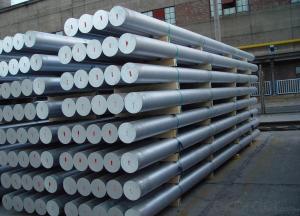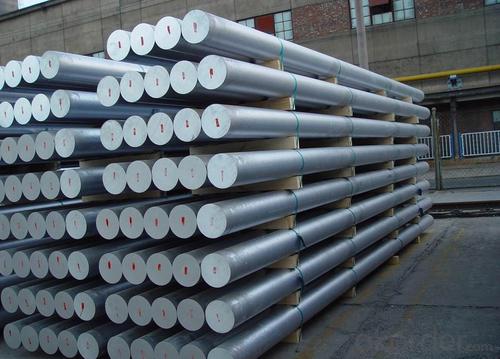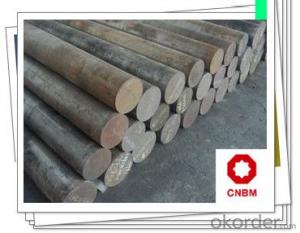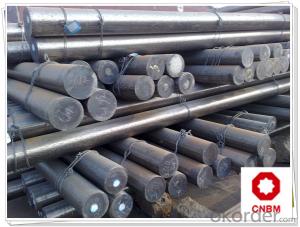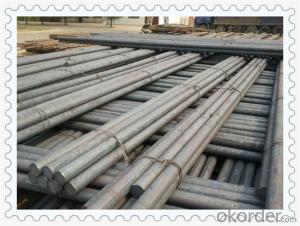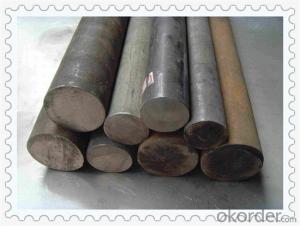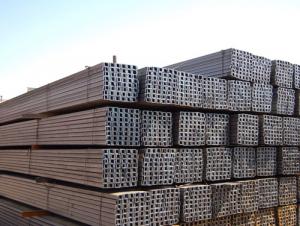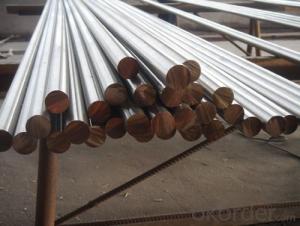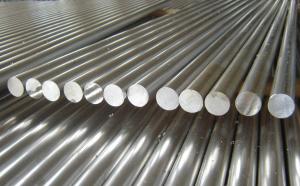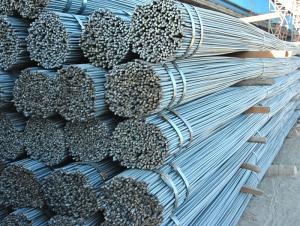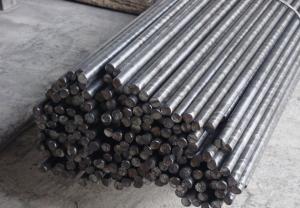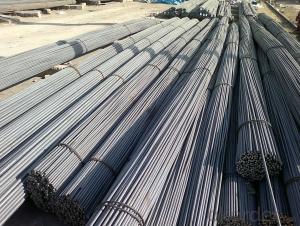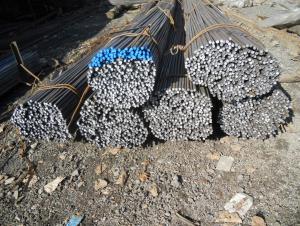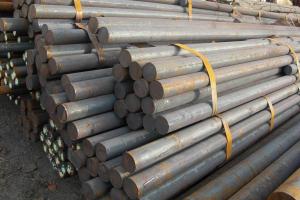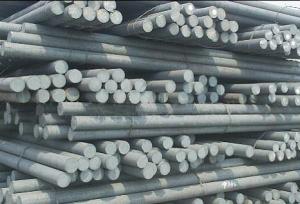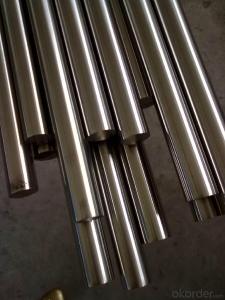Round bar Q235 Hot Rolled High Quality 5MM-100MM
- Loading Port:
- Tianjin
- Payment Terms:
- TT or LC
- Min Order Qty:
- 25 m.t.
- Supply Capability:
- 200000 m.t./month
OKorder Service Pledge
OKorder Financial Service
You Might Also Like
Product Description:
OKorder is offering Round bar Q235 Hot Rolled High Quality 5MM-100MM at great prices with worldwide shipping. Our supplier is a world-class manufacturer of steel, with our products utilized the world over. OKorder annually supplies products to European, North American and Asian markets. We provide quotations within 24 hours of receiving an inquiry and guarantee competitive prices.
Product Applications:
According to the needs of different structures, Angle can compose to different force support component, and also can be the connections between components. It is widely used in various building structures and engineering structures such as roof beams, bridges, transmission towers, hoisting machinery and transport machinery, ships, industrial furnaces, reaction tower, container frame and warehouse etc
Product Advantages:
OKorder's Round bar Q235 Hot Rolled High Quality 5MM-100MM are durable, strong, and resist corrosion.
Main Product Features:
· Premium quality
· Prompt delivery & seaworthy packing (30 days after receiving deposit)
· Corrosion resistance
· Can be recycled and reused
· Mill test certification
· Professional Service
· Competitive pricing
Product Specifications:
Manufacture: Hot rolled
Grade: Q195 – 235
Certificates: ISO, SGS, BV, CIQ
Length: 6m – 12m, as per customer request
Packaging: Export packing, nude packing, bundled
Sizes: 25mm-250mm | ||||||||||||
a*t | ||||||||||||
25*2.5-4.0 | 70*6.0-9.0 | 130*9.0-15 | ||||||||||
30*2.5-6.6 | 75*6.0-9.0 | 140*10-14 | ||||||||||
36*3.0-5.0 | 80*5.0-10 | 150*10-20 | ||||||||||
38*2.3-6.0 | 90*7.0-10 | 160*10-16 | ||||||||||
40*3.0-5.0 | 100*6.0-12 | 175*12-15 | ||||||||||
45*4.0-6.0 | 110*8.0-10 | 180*12-18 | ||||||||||
50*4.0-6.0 | 120*6.0-15 | 200*14-25 | ||||||||||
60*4.0-8.0 | 125*8.0-14 | 250*25 | ||||||||||
FAQ:
Q1: How soon can we receive the product after purchase?
A1: Within three days of placing an order, we will begin production. The specific shipping date is dependent upon international and government factors, but is typically 7 to 10 workdays.
Q2: What makes stainless steel stainless?
A2: Stainless steel must contain at least 10.5 % chromium. It is this element that reacts with the oxygen in the air to form a complex chrome-oxide surface layer that is invisible but strong enough to prevent further oxygen from "staining" (rusting) the surface. Higher levels of chromium and the addition of other alloying elements such as nickel and molybdenum enhance this surface layer and improve the corrosion resistance of the stainless material.
Q3: Can stainless steel rust?
A3: Stainless does not "rust" as you think of regular steel rusting with a red oxide on the surface that flakes off. If you see red rust it is probably due to some iron particles that have contaminated the surface of the stainless steel and it is these iron particles that are rusting. Look at the source of the rusting and see if you can remove it from the surface.
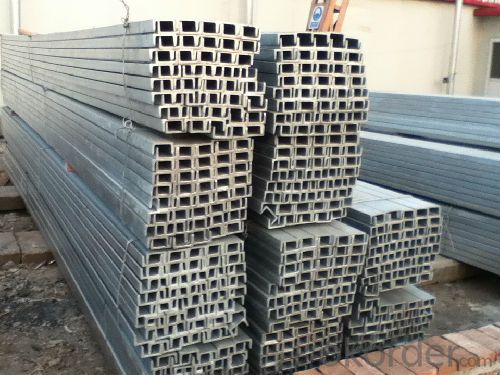
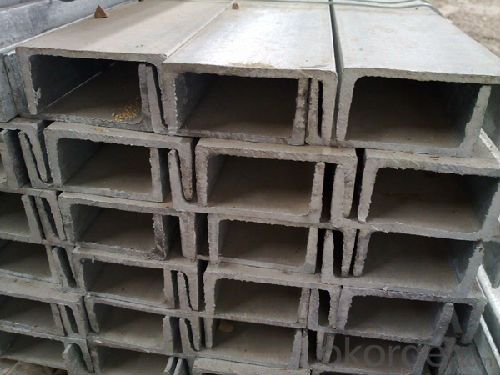
- Q: What are the advantages of using nickel-manganese alloy steel round bars?
- There are several advantages of using nickel-manganese alloy steel round bars in various applications. Firstly, nickel-manganese alloy steel round bars offer excellent strength and toughness. The addition of nickel and manganese enhances the overall strength and durability of the steel, making it suitable for heavy-duty applications that require high strength and resistance to wear and tear. This makes the alloy steel round bars ideal for industries such as construction, automotive, and manufacturing. Secondly, nickel-manganese alloy steel round bars have excellent corrosion resistance properties. The nickel content in the alloy provides exceptional resistance to corrosion, making it suitable for applications in harsh environments or where exposure to corrosive substances is common. This corrosion resistance extends the lifespan of the round bars and reduces the need for frequent maintenance or replacement. Another advantage of using nickel-manganese alloy steel round bars is their excellent heat resistance. The alloy steel can withstand high temperatures without losing its structural integrity, making it suitable for applications that involve exposure to extreme heat or thermal cycles. This heat resistance property makes the round bars ideal for use in industries such as aerospace, power generation, and oil and gas. Furthermore, nickel-manganese alloy steel round bars offer good weldability and machinability. The alloy's composition allows for easy welding and machining, enabling manufacturers to fabricate components or structures with ease. This versatility in processing makes the round bars highly adaptable to different manufacturing processes and requirements. Additionally, nickel-manganese alloy steel round bars have good ductility and formability. The alloy's composition allows it to be easily shaped or formed into various configurations without sacrificing its structural integrity. This formability makes it suitable for applications that require complex shapes or intricate designs. Overall, the advantages of using nickel-manganese alloy steel round bars include excellent strength, corrosion resistance, heat resistance, weldability, machinability, and formability. These properties make the round bars a reliable and versatile choice for a wide range of applications in various industries.
- Q: Are steel round bars corrosion resistant?
- No, steel round bars are not inherently corrosion resistant. Steel is primarily made of iron, and iron is prone to rusting when exposed to moisture and oxygen. However, there are certain types of steel that are specifically designed to be corrosion resistant. These types of steel, such as stainless steel, contain additional alloying elements like chromium and nickel, which form a protective layer on the surface of the steel, preventing rust and corrosion. So, while regular steel round bars are not corrosion resistant, there are corrosion-resistant options available in the form of stainless steel round bars.
- Q: What is the difference between a polished and a hot rolled steel round bar?
- The main difference between a polished and a hot rolled steel round bar lies in their manufacturing processes and the resulting surface finish. Hot rolled steel round bars are produced by heating a steel billet or ingot to high temperatures and then rolling it into the desired shape, typically a round bar. This process results in a rough and uneven surface finish with mill scale and imperfections. The hot rolled bars are generally used for applications where surface finish is not critical, such as structural components, machinery parts, and construction materials. On the other hand, polished steel round bars undergo additional processing to achieve a smooth and shiny surface finish. After the hot rolling process, the bars are processed through various grinding and polishing techniques to remove the mill scale, surface imperfections, and achieve a uniform finish. This results in a refined and aesthetically pleasing surface that is suitable for applications where appearance and visual appeal matter, such as decorative items, furniture, and architectural components. In addition to the surface finish, the mechanical properties of the two types of steel round bars can also differ. The hot rolled bars generally have a rougher surface and may exhibit some residual stresses, while the polished bars have a smoother surface and reduced internal stresses. However, the overall mechanical properties, such as strength and hardness, are primarily determined by the grade and composition of the steel used, rather than the manufacturing process or surface finish. In summary, the difference between a polished and a hot rolled steel round bar lies in their surface finish. Hot rolled bars have a rough and uneven surface with mill scale and imperfections, while polished bars undergo additional processing to achieve a smooth and shiny finish. The choice between the two depends on the specific application and the desired appearance of the final product.
- Q: Are steel round bars suitable for food processing applications?
- Steel round bars are commonly used in food processing applications due to their many desirable properties. Firstly, steel is highly durable and can withstand heavy usage and frequent cleaning in food processing environments. This makes it an ideal choice for equipment such as conveyor belts, mixers, and cutting tools. Additionally, steel round bars are resistant to corrosion, which is crucial in food processing applications where exposure to moisture and various chemicals is common. This resistance ensures that the equipment remains hygienic and safe for food production. Furthermore, steel round bars can be easily machined and fabricated into different shapes and sizes, making them versatile for various food processing needs. They can be used to create custom equipment or parts that meet specific requirements, ensuring efficient and effective food processing operations. Lastly, steel is a cost-effective material for food processing applications. It offers excellent value for money, as it provides long-lasting performance, requires minimal maintenance, and can be readily available in the market. However, it is important to note that not all steel round bars are suitable for food processing applications. Stainless steel is the most commonly used type of steel in this industry due to its enhanced corrosion resistance and hygienic properties. Therefore, when choosing steel round bars for food processing applications, it is crucial to ensure that they meet the necessary standards and regulations for food safety.
- Q: What is the maximum weight capacity of a steel round bar?
- The maximum weight capacity of a steel round bar depends on various factors, including the diameter and length of the bar, as well as the specific grade and type of steel used. Steel round bars come in various sizes and grades, each with different load-bearing capacities. To determine the maximum weight capacity of a steel round bar, it is necessary to consider its cross-sectional area, which is calculated using the formula: Area = π * (diameter/2)^2, where π is a mathematical constant approximately equal to 3.14159. Once the cross-sectional area is determined, it can be multiplied by the density of the specific steel grade to estimate the weight of the bar. The density of steel varies depending on the grade, but as a general approximation, it is around 7850 kilograms per cubic meter (or 0.00785 grams per millimeter cubed). However, it is important to note that weight capacity alone may not be the sole determining factor for the safe use of a steel round bar. Other considerations such as load distribution, applied forces, and the bar's structural integrity are equally important in ensuring its safe operation. To obtain precise weight capacity information for a specific steel round bar, it is recommended to consult the manufacturer's specifications or reach out to a qualified engineer or professional who can provide accurate calculations based on the specific requirements and characteristics of the steel round bar in question.
- Q: How many roots are there in a standard ton of steel and how many meters are there in a steel bar?
- The general drawing bar is 6 meters, some ribbed bars 9 meters and 12 meters two tons of steel; a number of roots can not say, can be 1 or 100 roots, the length of thickness do not know how to tell you how many tons of reinforced root ah.
- Q: Can steel round bars be used for making decorative items?
- Certainly, decorative items can indeed be created using steel round bars. With their ability to be shaped, bent, and welded, steel round bars offer a wide range of options for designing various decorative patterns. They possess durability and strength, making them suitable for both indoor and outdoor uses. Decorative furniture, sculptures, railings, gates, light fixtures, and many other items can be crafted from steel round bars. Their sleek and contemporary appearance adds an industrial and modern touch to any space. Furthermore, steel round bars can be finished with different coatings or treatments, such as powder coating or patina, to enhance their visual appeal and protect against corrosion. Consequently, steel round bars are an exceptional choice for creating decorative items because of their versatility, strength, and ability to infuse a stylish and distinctive element into any design.
- Q: How do you prevent steel round bars from rusting during transportation?
- There are several effective measures that can be taken to prevent rusting of steel round bars during transportation. Firstly, it is crucial to properly package the steel round bars. This involves securely wrapping and sealing them using moisture-resistant materials like plastic or shrink wrap. This packaging will act as a barrier against moisture and prevent direct contact with air. Secondly, the inclusion of desiccants inside the packaging can help absorb any moisture that may be present. Desiccants such as silica gel packets or moisture-absorbing clay will create a dry environment around the steel bars, reducing the chances of rust formation. Another effective method is to use VCI (Volatile Corrosion Inhibitor) packaging. VCI materials release a protective vapor that forms a thin layer on the steel surface, inhibiting corrosion. VCI films or papers can be utilized to wrap the steel round bars, providing long-lasting rust protection. Proper storage conditions are also crucial during transportation. The steel round bars should be stored in a dry and well-ventilated environment, away from rain, humidity, and extreme temperature fluctuations. If possible, they should be stored in a covered and climate-controlled area to minimize the risk of rust formation. Regular inspection and maintenance of the steel round bars during transportation is essential. This ensures that the packaging remains intact and no moisture has seeped in. If any damage or signs of moisture are detected, immediate action should be taken to rectify the issue and prevent rust from spreading. By implementing these preventive measures, the risk of rust formation on steel round bars during transportation can be significantly reduced, guaranteeing that they arrive at their destination in optimal condition.
- Q: Can steel round bars be used for making suspension springs?
- Yes, steel round bars can be used for making suspension springs. Steel is a common material choice for suspension springs due to its strength, durability, and ability to withstand high loads and vibrations. Steel round bars can be readily shaped, tempered, and heat-treated to meet the specific requirements of suspension springs, providing necessary flexibility and resilience.
- Q: Is round steel round steel?
- Round steel is a solid strip of steel whose cross section is round. The specifications are expressed in millimeters of diameter, such as "50", which means a round bar of 50 millimeters in diameter.
Send your message to us
Round bar Q235 Hot Rolled High Quality 5MM-100MM
- Loading Port:
- Tianjin
- Payment Terms:
- TT or LC
- Min Order Qty:
- 25 m.t.
- Supply Capability:
- 200000 m.t./month
OKorder Service Pledge
OKorder Financial Service
Similar products
Hot products
Hot Searches
